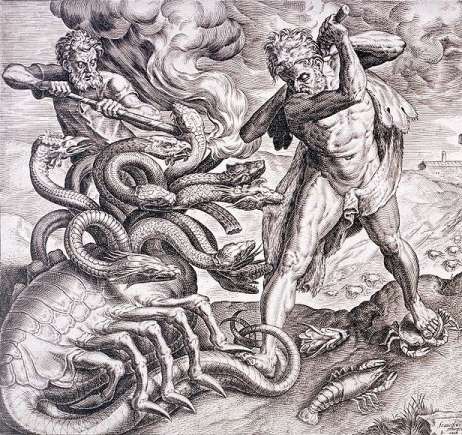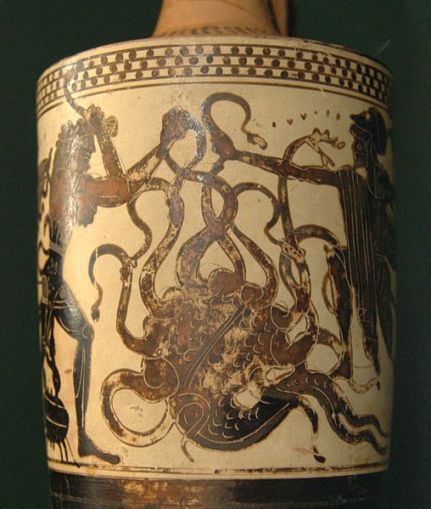The Lernaean Hydra was a multi-headed giant serpentine monster; a water creature with extremely poisonous blood and breath. She was haunting the dark bog of the lake Lerna in Argolis. The second labor of Heracles was to slay the Hydra and rid the land of Argolis of her noxious presence.
Key Facts
| Parents | Typhon and Echidna |
| Region | Marshland of lake Lerna, Argolis, East Peloponnese |
| Siblings | Caucasian Eagle, Cerberus, Chimera, Colchian Dragon, Crommyonian Sow, and Orthus |
| Offspring | None |
| Names | Hydra of Lerna, Lernaean Hydra, Lernaia Hydra |
| Ancient Greek | Λερναῖα Ὕδρα |
Origins of the Lernaean Hydra

The Lernaean Hydra is said to be the most horrifying and deadly monster among the seven atrocious offspring of Typhon and Echidna. Her poison blood and breath combined with the fact that she couldn’t be slain by any sort of blade made her more imposingly terrible than the rest of her siblings such as Cerberus and Chimera were.
The venomous Hydra was maliciously raised by the goddess Hera for the single purpose of killing Heracles, The Strongest Hero. Yet, as the myth reveals she met her demise when the great demigod hero confronted her in the swamps of Lerna.
Etymology
The name ‘Lernaean’ indicates the location where the gruesome creature had its lair; a murky swamp by the lake of Lerna in Argolis, East Peloponnese. ‘Hydra’ generally means water, however, a more specific term gives the explanation of ‘water snake’. Hence, Lernaean Hydra is interpreted as the ‘water snake (serpent) of lake Lerna’.
Impact
The popularity of the account of Heracles’ Second Labor owes much to the uniqueness of its monster. Irrefutably, this enabled the Lernaean Hydra to become something more than just a foul entity.
It is also the name of a constellation, and moreover any of a variety of small tubular freshwater hydrozoan polyps with a mouth at one end surrounded by tentacles.
Play Hydra Quiz
How well do you know Hydra and other Greek monsters? Play this game to find out!
If you enjoyed this game, there are many more games on our website! Try them!
The Myth of the Lernaean Hydra
The setting
A perpetual deathly mist covers the swamps of Lake Lerna in Argolis. Everyone who cherishes their lives shuns this horrible place. But, beyond the traplike mud patches of ground and the bare trees with the twisted branches lies a nightmarish monster that threatens the residents of the neighboring settlements. People have gone missing, and witnesses have seen the wicked beast crawling back into the bog of the lake.
The beast
The Lernaean Hydra was a giant water serpent with six or nine heads. She spewed toxic fumes and the blood in her veins was a pure, lethal poison. The most remarkable feature of the Hydra was that she could grow back a pair of heads for each one that was cut off. This made her impossible to slay and without a doubt one of the most formidable monsters in the ancient world.
The hero
King Eurystheus of Tiryns decreed that for his second labor, Heracles had to kill the vicious Hydra of Lerna. Arriving at the marshland near the lake, the hero covered his mouth and nose in order not to inhale the fatal toxic gases that swarmed the place. The beast’s lair was inside a cave in the middle of the swamp, in the spot of a tainted spring. Heracles shot several fire arrows at the cave’s mouth and provoked the monster to appear. The Hydra attacked at once, writhing and snapping at him.

Heracles swiftly chopped off several of the monster’s heads, but to his astonishment, two new ones sprouted for each one he severed. Realizing the challenge he faced, he turned to his nephew, Iolaus, for assistance. Fortunately, Iolaus had received guidance from the goddess Athena in a dream. He suggested burning the Hydra’s headless stumps before it could regenerate. Following this advice, Heracles successfully prevented the beast from regrowing its heads. Meanwhile, it’s believed that Hera dispatched a giant crab to aid the Hydra. Nevertheless, Heracles quickly stomped on it, crushing it beneath his foot.
The Lernaean Hydra was ultimately slain by Heracles who decapitated all of her heads except for one and burned her serpentine body to ashes. The demigod cut off the last head of the monster, which was said to be immortal and thus couldn’t be destroyed, using a golden sword given to him by Athena. He then dipped his arrows in the poisonous blood of the severed and still alive head before hiding it under a boulder, never again to see the light of day.
Depictions
The earliest description of the vile mythological beast presents it as having nine heads. Other accounts reduce the number of the Hydra heads to six, three and even one. Another however raises it to fifty. Whereas the heads differ in quantity the monster nonetheless remains the same; large, horrible and full of poison.
In art, sculptures and pottery, the Lernaean Hydra appears as a multi-headed serpent. Othen it is fighting Heracles, who on most occasions is armed with his club.
Roles and Responsibilities
The monster Hydra was reared by the envious goddess Hera. Moreover, it only had one purpose: to kill the demigod son of Zeus, Heracles. Such was the enmity of the queen of the gods that she took no pity on the people living in the vicinity of lake Lerna. The Lernaean Hydra was supposed to be the bane of Heracles. However, that didn’t happen, much because of the precious aid of the goddess Athena.
In the old texts

Greek
The Lernaean Hydra is mentioned in:
Alcaeus’ Fragment,
Alcman’s Fragment,
Apollodorus’ Bibliotheca,
Apollonius Rhodius’ Argonautica,
Diodorus Siculus’ Bibliotheca Historica,
Euripides’ Heracles,
Hesiod’s Theogony,
Nonnos’ Dionysiaca,
Pausanias’ Description of Greece,
Philostratus’ Life of Apollonius of Tyana,
Plato’s Euthydemus,
Simonides’ Fragment,
Sophocles’ Trachinae,
and Strabo’s Geography.
‘τὸ τρίτον Ὕδρην αὖτις ἐγείνατο λυγρὰ ἰδυῖαν
Λερναίην, ἣν θρέψε θεὰ λευκώλενος Ἥρη
ἄπλητον κοτέουσα βίῃ Ἡρακληείῃ.
Καὶ τὴν μὲν Διὸς υἱὸς ἐνήρατο νηλέι χαλκῷ
Ἀμφιτρυωνιάδης σὺν ἀρηιφίλῳ Ἰολάῳ
Ἡρακλέης βουλῇσιν Ἀθηναίης ἀγελείης.’
‘and third, a Hydra, malicious and grisly,
The Lernaean that the white-armed goddess
Hera nourished, infinitely peeved with Heracles,
The son of Zeus (but of the house of Amphitryon)
Who used merciless bronze to harm the monster
With Iolaos’ help and Athena’s strategy.’
(Hesiod’s Theogony 313-318)
‘ποίους ποτ᾽ ἢ λέοντας ἢ τρισωμάτους
Τυφῶνας ἢ Γίγαντας ἢ τετρασκελῆ
κενταυροπληθῆ πόλεμον οὐκ ἐξήνυσα;
τήν τ᾽ ἀμφίκρανον καὶ παλιμβλαστῆ κύνα
ὕδραν φονεύσας μυρίων τ᾽ ἄλλων πόνων’
‘what did I not destroy, whether lions, or triple-bodied
Typhons, or giants or the battle against
the hosts of four-legged Centaurs, The Half-Human, Half-Horse Beings?
or how when I had killed the hydra, that monster with a
ring of heads with power to grow again’
(Euripides’ Heracles 1271-1275)
Roman
The Lernaean Hydra appears in:
Boethius’ The Consolation of Philosophy,
Hyginus’ Astronomica and Fabulae,
Lucretius’ Of The Nature of Things,
Ovid’s Heroides and Metamorphoses,
Propertius’ Elegies,
Seneca’s Hercules Furens,
Statius’ Thebaid and Silvae,
Valerius Flaccus’ Argonautica,
and Virgil’s Aeneid.
‘denique quid Cretae taurus Lernaeaque pestis
hydra venenatis posset vallata colubris?’
‘What of the Cretan Bull, The Mighty Beast or that Lernaean pestilence,
the hydra, guarded by her wall of venomous snakes?’
(Lucretius’ Of The Nature of Things, Book V, 27-28)
‘nec magis aut illis aut illis milibus ultra
sufficit, ad dirae quam cum Tirynthius Hydrae
agmina Palladios defessus respicit ignes.’
‘Yet suffices he not for the thousands who on this side and on that are springing up,
any more than when the Tirynthian (Heracles) wearied in fight against the Hydra’s
dreadful hosts turned to the fires of Pallas (Athena).’
(Valerius Flaccus’ Argonautica, Book VII, 622-624)
FAQs
The Hydra of lake Lerna was a wingless serpent, not a dragon, with six or nine heads. Its blood was poison and so was its breath, spewing toxic fumes that engulfed its lair.
Featured Image Credit: Gustave Moreau, Public domain, via Wikimedia Commons
